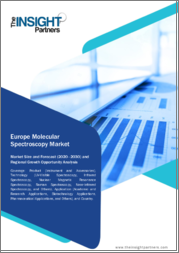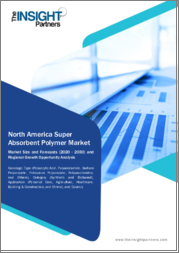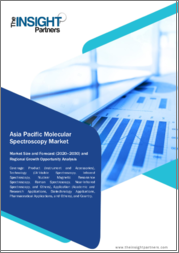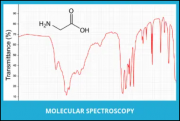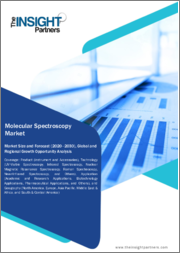
|
시장보고서
상품코드
1840654
분자분광 시장 : 유형, 제품 유형, 전개, 용도, 최종사용자별 - 세계 예측(2025-2032년)Molecular Spectroscopy Market by Type, Product Type, Deployment, Application, End User - Global Forecast 2025-2032 |
||||||
분자분광 시장은 2032년까지 연평균 복합 성장률(CAGR) 5.54%로 119억 7,000만 달러에 이를 것으로 예측됩니다.
| 주요 시장 통계 | |
|---|---|
| 기준 연도 : 2024년 | 77억 7,000만 달러 |
| 추정 연도 : 2025년 | 82억 1,000만 달러 |
| 예측 연도 : 2032년 | 119억 7,000만 달러 |
| CAGR(%) | 5.54% |
기기 혁신, 데이터 통합, 규제 강화로 인해 실험실과 현장에서 분자 분광학 실습이 어떻게 재편되고 있는지에 대한 명쾌하고 권위 있는 입문서.
분자 분광학은 생명과학, 산업 품질 관리, 환경 모니터링에서 화학적 특성 분석, 구조 규명, 정량 분석의 근간을 이루고 있습니다. 이 주요 요약은 분광학 워크플로우를 지원하는 장비, 소모품, 소프트웨어 및 서비스를 형성하는 현대의 역학을 요약한 것입니다. 조달 및 R&D 과제에 영향을 미치는 기술적 변곡점, 규제 추진력, 최종 사용자의 기대치를 파악하는 데 초점을 맞추었습니다.
검토 기간 초기에 업계는 장비가 데이터 분석 플랫폼 및 라이프사이클 지원과 결합된 통합 솔루션에 중점을 두기 시작했습니다. 검출기 기술, 컴팩트한 솔리드 스테이트 설계, 클라우드 지원 분석 기술의 발전으로 분산형 환경에서의 채택이 가속화되고 있지만, 전통적인 실험실 환경에서는 여전히 높은 처리량과 견고한 플로어 스탠딩 시스템이 우선순위를 차지하고 있습니다. 그 결과, 이해관계자들은 이동성과 정확성의 균형을 맞추게 되었고, 공급업체들은 휴대용 현장 장치부터 벤치탑이나 바닥에 설치되는 분석 플랫폼에 이르기까지 모듈식 포트폴리오를 제공하게 되었습니다.
전체적으로 장비의 성능과 디지털 기능의 융합이 눈에 띕니다. 데이터 무결성, 추적성, 재현성, 특히 규제 준수와 연구 재현성이 교차하는 경우 데이터 무결성, 추적성, 재현성은 점점 더 우선순위가 높아지고 있습니다. 이러한 영향은 조달 전략과 진화하는 과학적 및 규제적 요구사항에 대한 분석 워크플로우의 미래를 보장하고자 하는 R&D 팀에게 중요한 의미를 지닙니다.
장비의 소형화, 소프트웨어 기반 분석, 지속가능성 의무화가 분광학 분야의 조달, 도입 및 수명주기 지원 전략을 어떻게 재정의하고 있는가?
분자 분광학의 상황은 소형화, 소프트웨어 중심의 차별화, 분야 간 응용 확대 등으로 크게 변화하고 있습니다. 장비 제조업체들은 소형의 에너지 효율적인 검출기와 광원의 개발을 가속화하여 in-situ 스크리닝에 적합한 신뢰할 수 있는 휴대용 라만, UV-Vis, 적외선 시스템을 실현하고 있습니다. 동시에 핵 자기 공명 장치와 형광 장치의 발전은 복잡한 생물학적 매트릭스에 대한 민감도와 다중화를 계속 우선시하고 있습니다.
이와 함께, 원격 장비 관리, 예지보전, 첨단 케모메트릭스 분석을 가능하게 하는 소프트웨어 생태계에 대한 관심도 높아지고 있습니다. 벤더들은 머신러닝 파이프라인을 통합하여 스펙트럼 해석을 강화하고, 일상적인 작업을 자동화하여 작업자에 대한 의존도를 낮추고 통찰력 도출 시간을 단축하고 있습니다. 그 결과, 의사결정자들은 장비와 강력한 데이터 분석 소프트웨어, 교정 및 교육 등의 지속적인 서비스를 결합한 완벽한 솔루션에 높은 가치를 부여하고 있습니다.
마지막으로, 규제와 지속가능성에 대한 고려가 제품 설계와 공급망에 영향을 미치고 있습니다. 소모품 및 용매는 환경 영향 및 CoC 추적성 측면에서 점점 더 엄격해지고 있으며, 공급업체는 재활용 가능한 재료 및 표준화된 표준 물질에 대한 기술 혁신을 촉진하고 있습니다. 이러한 복합적인 변화로 인해 실험실과 현장 팀은 조달 우선순위를 재검토하고 장비, 소모품, 소프트웨어의 라이프사이클 지원을 제공할 수 있는 파트너십에 우선순위를 두어야 합니다.
2025년 관세가 미국 분광학 이해관계자 전체의 조달, 조립, 서비스 전략을 재편하는 가운데, 정책 주도의 비용 압박과 공급망 재편을 극복하기 위해
2025년 관세 조정과 무역 정책의 전환은 미국의 분광학 관련 상품 및 서비스 공급망, 조달 시기, 가격 결정 역학에 중층적인 영향을 미칠 것입니다. 수입 관련 과세는 부품, 완제품, 특정 액세서리에 영향을 미치며, 이에 따라 국내 구매자와 해외 공급업체 모두의 조달 계산이 달라집니다. 실제로 조달팀은 공급업체를 다양화하고, 중요한 소모품의 재고 버퍼를 늘리고, 국경 간 비용 변동에 따른 영향을 줄이기 위해 가능한 한 현지 조달을 추진함으로써 대응해 왔습니다.
이러한 무역 역학은 제조업체가 최종 조립 및 테스트 업무를 어디에 배치하는지에 영향을 미칩니다. 일부 업체들은 지역화 전략을 가속화하고, 리드 타임을 단축하고, 관세 재설정의 영향을 줄이기 위해 주요 고객 클러스터 근처로 생산 기지를 이전하고 있습니다. 이에 따라 서비스 네트워크와 유지보수 생태계도 변화하여 예비 부품 공급, 지역 밀착형 교육, 벤치탑 및 바닥 설치형 시스템의 가동 시간 유지를 위한 인증 획득 등에 중점을 두게 되었습니다.
기술 혁신의 관점에서 볼 때, 정책 주도의 비용 압박으로 인해 공급업체는 부품 조달을 재검토하고 관세가 부과되는 입력에 대한 의존도를 줄이기 위해 설계 변경을 모색하게 되었습니다. 조직 차원에서는 조달 경로가 선행 가격에만 주목하는 것이 아니라 관세 적용, 물류 리스크, 서비스 연속성을 포함한 총소유비용을 고려하는 방향으로 변화하고 있습니다. 이러한 행동은 전략적 조달과 무역 관련 리스크를 흡수하거나 배분할 수 있는 계약 구조의 중요성을 강조하고 있습니다.
기술, 제품 아키텍처, 도입 형태, 용도 도메인, 최종 사용자 프로파일이 어떻게 가치 제안과 조달 선택을 결정하는지 설명하는 심층 세분화 주도적 관점
형광법, 적외선법, 핵자기공명법, 라만법, UV-Vis법의 양식 차이에서 시작하는 통찰력 있는 세분화는 기술적 역량과 상업적 요구가 교차하는 지점을 명확히 합니다. 형광과 UV-Vis는 감도와 속도론에 중점을 둔 고처리량 스크리닝 및 생화학 분석에, 적외선과 라만(Raman)은 견뢰도에 중점을 둔 재료 식별 및 공정 모니터링에, 핵자기공명은 고해상도 성능이 최우선인 구조 해명과 복잡한 혼합물 분석에 있어 핵심적인 역할을 하고 있습니다.
제품 유형별 세분화에서는 액세서리와 소모품을 장비 본체, 소프트웨어, 서비스와 구분하고 있습니다. 액세서리 및 소모품에는 큐벳, 표준 물질, 샘플 바이알, 용매 등이 포함되며, 정기적인 구매 주기와 품질 관리의 원동력이 됩니다. 장비는 벤치탑형과 플로어 스탠딩형으로 나뉘며, 설치 공간과 처리량의 절충점을 반영합니다. 소프트웨어 및 서비스에는 데이터 분석 플랫폼, 유지보수 서비스, 교육 서비스가 포함되며, 효과적으로 통합되면 반복적인 수익원을 창출하고 벤더의 락인(Lock-in)을 강화할 수 있습니다.
휴대용 옵션과 고정형 옵션의 배포 선택은 채택 시나리오에 더 많은 영향을 미칩니다. 휴대용 장치는 현장 스크리닝, 규제 검사 또는 분산형 품질 검사에 우선순위를 두고, 고정형 시스템은 집약적인 실험실 워크플로우 및 고처리량 생산 환경을 지원합니다. 생명공학, 화학 분석, 환경 모니터링, 식음료 품질 관리, 의약품 개발 등의 개발 현장에서는 각각 고유한 검증, 민감도, 컴플라이언스 요구사항이 있으며, 이는 장비 선택에 반영됩니다. 학술 기관, 화학 연구소, 계약 연구 기관, 산업 연구 개발, 제약 연구소와 같은 최종 사용자 부문은 조달 주기, 자본 제약, 기대되는 서비스가 다르기 때문에 공급업체는 각각에 맞는 상업적 모델과 애프터 서비스로 대응해야 합니다.
미주, 유럽-중동 및 아프리카, 아시아태평양의 조달 행동, 규제 뉘앙스, 산업 구성, 제품 배분 및 서비스 전략이 어떻게 형성되고 있는지를 파악할 수 있는 지역 비교 분석
지역적 역학관계에 따라 북미, 남미, 유럽, 중동/아프리카, 아시아태평양별로 차별화된 수요 촉진요인과 경쟁 패턴이 드러납니다. 북미와 남미에서는 산업 R&D, 제약 제조, 학술 연구의 강력한 융합이 고성능 실험실 시스템에 대한 지속적인 수요를 뒷받침하는 한편, 규제 프레임워크와 지역별 공급망이 벤더 전략을 형성하고 있습니다. 유럽, 중동 및 아프리카에서는 규제 조화, 환경 모니터링의 우선순위, 분산형 검사에 대한 투자 확대가 지속가능성과 컴플라이언스에 중점을 둔 휴대용 및 벤치탑 기술에 대한 수요를 자극하고 있습니다.
아시아태평양은 다양화가 두드러지게 나타나고 있습니다. 첨단 제조 시설과 대규모 위탁 연구 부서가 고처리량 플로어 스탠딩 시스템과 소형 탁상용 솔루션의 채택을 촉진하는 한편, 현지 제조 및 모듈식 서비스 네트워크에 대한 투자가 증가하고 있습니다. 지역 간 조달 주기의 차이, 관세 적용 범위, 현지 인증 요건은 벤더가 판매 파트너십과 애프터서비스 네트워크를 구성하는 방식에 영향을 미칩니다. 그 결과, 제품 모듈화와 각 지역의 서비스 역량 및 규제 지침의 정합성을 확보한 기업은 운영의 탄력성과 고객의 신뢰성을 높일 수 있습니다.
통합 솔루션, 정기적인 서비스, 파트너십 중심의 기능 확장에 중점을 둔 경쟁 전략이 벤더의 회복력과 고객 유지에 영향을 미칩니다.
스펙트럼 스코프 생태계에서 경쟁의 위치는 솔루션의 폭, 서비스의 깊이, 하드웨어와 소프트웨어를 통합하여 일관된 제품을 제공하는 능력에 의해 정의되고 있습니다. 주요 제조업체들은 가동시간과 유지보수성 향상을 통해 총소유비용을 절감하는 장비에 투자하고 있으며, 동시에 원시 스펙트럼 데이터에 해석적 가치를 더하는 분석 제품군을 개발하고 있습니다. 소프트웨어 기업 및 제3자 서비스 제공업체와의 전략적 파트너십을 통해 역량 격차를 해소하고 최종 사용자 가치 실현 시간을 단축하는 것이 일반화되고 있습니다.
동시에 틈새 소모품, 검량선 표준기, 고감도 검출기를 전문으로 하는 전문 업체는 정기적인 구매와 품질 관리가 장기적인 고객 관계를 유지하기 위해 강력한 관련성을 유지하고 있습니다. 신속한 교정 처리, 인증된 교육 프로그램, 예측 가능한 유지보수 계약 등으로 대표되는 탁월한 서비스는 특히 연속성과 추적성이 중요한 규제 산업에서 조달 결정에 있어 중요한 차별화 요소로 작용합니다.
신규 진출기업들은 장비의 구독 기반 액세스, 사용량에 따라 가격이 책정되는 클라우드 네이티브 애널리틱스, 환경 발자국을 줄이는 지속가능성 중심의 소모품 등 파괴적인 방식을 추구하는 경우가 많습니다. 기존 기업은 설치 기반의 가치를 유지하고 지속적인 수익원을 창출하기 위해 포트폴리오 확대, 채널 네트워크 심화, 라이프사이클 서비스 공식화를 통해 대응합니다.
공급업체와 구매자가 포트폴리오, 공급망, 상업적 모델을 강화하고 분산형 실험실에서 채택을 가속화하기 위한 실행 가능한 전략적 필수 사항
업계 리더는 내구성이 뛰어난 장비, 검증된 소모품, 고급 분석을 결합한 통합 제품 및 서비스 포트폴리오를 우선순위에 두어야 합니다. 모듈형 아키텍처에 투자하면 휴대용 및 고정식 환경 모두에 대한 배포가 간소화되며, 고객은 데이터 연속성을 유지하면서 현장 스크리닝에서 완전한 실험실 통합까지 확장할 수 있습니다. 또한, 명확한 유지보수 및 교육 경로를 구축하여 가동 시간을 개선하고 규제 부문의 고객 운영 리스크를 줄일 수 있습니다.
공급망의 견고함도 필수 조건입니다. 리더는 부품 공급원을 다양화하고, 가능한 경우 지역 조립 능력을 확대하고, 중요한 소모품에 대한 비상 대응 계획을 공식화해야 합니다. 소모품의 재활용 가능성, 용제 관리, 추적 가능한 참조 표준 등 투명한 라이프사이클 관리는 지속가능성에 대한 요구와 새로운 규제 당국의 기대에 부응하는 것입니다. 동시에 예지보전 및 원격 진단을 서비스에 통합하여 다운타임을 줄이고 장기적인 고객과의 관계를 강화할 수 있습니다.
마지막으로, 상업적 혁신이 중요합니다. 리스, 구독 기반 분석, 성과 지향적 서비스 계약을 포함한 유연한 구매 모델을 검토합니다. 이러한 접근방식은 소규모 연구기관의 인수 장벽을 낮추고, 분산형 사용자의 채택을 가속화하며, 공급업체의 지속적인 수익을 보장하고, 성과와 사용자 만족도에 대한 인센티브를 조정할 수 있습니다.
전문가 인터뷰, 공급업체 참여, 기술 문헌 검토를 결합한 투명한 다중 소스 조사 프레임워크를 통해 분광학 이해관계자에게 실용적이고 재현 가능한 통찰력을 보장합니다.
이 보고서의 기초가 되는 조사는 전문가 질적 인터뷰, 공급업체 및 최종 사용자를 대상으로 한 1차 조사, 기술 문헌 및 규제 지침에 대한 체계적 검토를 결합하여 이루어졌습니다. 장비 엔지니어, 조달 책임자, 실험실 관리자, 데이터 사이언스자를 대상으로 인터뷰를 실시하여 기술 선택, 소모품 품질, 소프트웨어 유틸리티와 관련된 실제 채택 촉진요인, 애로사항, 선호도 등을 파악했습니다. 공급업체와의 대화를 통해 제품 로드맵, 지역별 생산 전략, 애프터서비스 모델을 공개했습니다.
2차 자료로는 동료평가 논문, 기술백서, 일반에 공개된 규제 문서 등을 활용하여 기술 궤적과 컴플라이언스 요건을 검증했습니다. 휴대용과 고정형이라는 두 가지 도입 시나리오의 비교 분석은 가동 시간, 사용 편의성, 데이터 통합에 대한 사용자 보고 지표뿐만 아니라 현장의 성능 데이터에 의존했습니다. 이러한 인풋을 통합하여 다양한 용도 영역과 최종 사용자 유형에 걸친 운영 현실을 반영하는 견고하고 실무 지향적인 결론을 도출하고, 이를 바탕으로 권고안을 구성합니다.
해당되는 경우, 이 조사 방법은 투명성을 중시합니다. 전제조건, 인터뷰 참여자 포함 기준, 세분화 선택에 대한 근거는 문서화되어 있어 재현성을 보장하고, 표적 추적 조사 및 맞춤형 분석 의뢰를 지원합니다.
기술 발전, 서비스 통합, 공급망 강인성을 분광학 실무자 및 공급업체의 성공의 주요 결정 요인으로 연관시키는 결론의 통합
요약: 스펙트럼 스코프의 상황은 기술 발전과 서비스 지향적 비즈니스 모델이 최종 사용자에게 새로운 가치를 제안하는 변곡점에 있습니다. 형광, UV-Vis, 적외선, 라만, 핵자기공명 등의 분야에서 장비는 계속 발전하고 있으며, 소프트웨어 지원 분석과 강력한 서비스 네트워크는 경쟁력 있는 제품에 필수적인 요소로 자리 잡고 있습니다. 휴대용 시스템에서 고정형 시스템까지 유연하게 구축할 수 있어 분산형에서 하이스루풋형까지 적용 범위가 넓어지고 있습니다.
2025년 규제와 무역의 발전은 탄력적인 공급망과 지역 맞춤형 서비스 모델의 필요성을 강조하고 있습니다. 제품의 차별화는 재현 가능한 결과를 제공하는 능력, 인증된 소모품 및 표준을 제공하는 능력, 교육 및 유지보수 프로그램을 통해 고객을 지원하는 능력에 달려있습니다. 조달 및 R&D 리더의 전략적 요구는 분명합니다. 장비의 성능, 소모품의 신뢰성, 분석의 깊이, 장기적인 운영 및 컴플라이언스 목표를 지원하는 통합 솔루션을 우선순위에 두는 것입니다.
이러한 결론을 종합하면, 협업, 모듈성, 탁월한 서비스가 벤더의 성공과 사용자 만족도를 결정하고, 기술 역량을 실용적인 배포와 지속가능성 목표에 부합하는 혁신의 길을 만들어내는 생태계를 가리킵니다.
목차
제1장 서문
제2장 조사 방법
제3장 주요 요약
제4장 시장 개요
제5장 시장 인사이트
제6장 미국 관세의 누적 영향 2025
제7장 AI의 누적 영향 2025
제8장 분자분광 시장 : 유형별
- 형광
- 적외선
- 핵자기공명
- 라만
- UV-Vis
제9장 분자분광 시장 : 제품 유형별
- 액세서리 및 소모품
- Cuvettes
- 참조 표준
- 샘플 바이알
- 용제
- 기기
- 벤치탑
- Floor-standing
- 소프트웨어 및 서비스
- 데이터 분석 소프트웨어
- 유지관리 서비스
- 트레이닝 서비스
제10장 분자분광 시장 : 전개 형태별
- 휴대용
- 고정형
제11장 분자분광 시장 : 용도별
- 바이오테크놀러지
- 화학제품
- 환경
- 식품 및 음료
- 의약품
제12장 분자분광 시장 : 최종사용자별
- 학술기관
- 화학 실험실
- 계약 연구기관
- 산업 연구개발
- 제약 실험실
제13장 분자분광 시장 : 지역별
- 아메리카
- 북미
- 라틴아메리카
- 유럽, 중동 및 아프리카
- 유럽
- 중동
- 아프리카
- 아시아태평양
제14장 분자분광 시장 : 그룹별
- ASEAN
- GCC
- EU
- BRICS
- G7
- NATO
제15장 분자분광 시장 : 국가별
- 미국
- 캐나다
- 멕시코
- 브라질
- 영국
- 독일
- 프랑스
- 러시아
- 이탈리아
- 스페인
- 중국
- 인도
- 일본
- 호주
- 한국
제16장 경쟁 구도
- 시장 점유율 분석, 2024
- FPNV 포지셔닝 매트릭스, 2024
- 경쟁 분석
- Thermo Fisher Scientific Inc.
- Agilent Technologies, Inc.
- PerkinElmer, Inc.
- Shimadzu Corporation
- Bruker Corporation
- JEOL Ltd.
- JASCO Corporation
- Waters Corporation
- Bio-Rad Laboratories, Inc.
- Metrohm AG
The Molecular Spectroscopy Market is projected to grow by USD 11.97 billion at a CAGR of 5.54% by 2032.
| KEY MARKET STATISTICS | |
|---|---|
| Base Year [2024] | USD 7.77 billion |
| Estimated Year [2025] | USD 8.21 billion |
| Forecast Year [2032] | USD 11.97 billion |
| CAGR (%) | 5.54% |
A crisp, authoritative primer on how instrument innovation, data integration, and regulatory rigor are reshaping molecular spectroscopy practice across laboratory and field operations
Molecular spectroscopy forms the analytical backbone for chemical characterization, structural elucidation, and quantitative analysis across life sciences, industrial quality control, and environmental monitoring. This executive summary synthesizes the contemporary dynamics shaping instrumentation, consumables, software, and services that support spectroscopic workflows. The focus is on clarifying technological inflection points, regulatory drivers, and end-user expectations that influence procurement and R&D agendas.
Early in the period under review, the industry sharpened its emphasis on integrated solutions where instruments are coupled with data analysis platforms and lifecycle support. Advances in detector technology, compact solid-state designs, and cloud-enabled analytics have accelerated adoption across decentralized settings, while long-established laboratory environments continue to prioritize high-throughput, rugged floor-mounted systems. Consequently, stakeholders now balance mobility and precision, driving suppliers to offer modular portfolios that span from portable field units to benchtop and floor-mounted analytical platforms.
Throughout, there is a pronounced convergence of instrumentation performance with digital capabilities. Data integrity, traceability, and reproducibility have risen in priority, particularly where regulatory compliance intersects with research reproducibility. The implications are significant for procurement strategies and for R&D teams seeking to future-proof analytical workflows against evolving scientific and regulatory requirements.
How instrument miniaturization, software-driven analytics, and sustainability mandates are collectively redefining procurement, deployment, and lifecycle support strategies in spectroscopy
The landscape of molecular spectroscopy is undergoing transformative shifts driven by miniaturization, software-led differentiation, and cross-disciplinary application expansion. Instrument manufacturers have accelerated development of compact, energy-efficient detectors and light sources, enabling reliable portable Raman, UV-Vis, and infrared systems suitable for in-situ screening. At the same time, advances in nuclear magnetic resonance and fluorescence instrumentation continue to prioritize sensitivity and multiplexing for complex biological matrices.
Parallel trends include a stronger emphasis on software ecosystems that enable remote instrument management, predictive maintenance, and advanced chemometric analysis. Vendors are embedding machine learning pipelines to enhance spectral interpretation and to automate routine tasks, which reduces operator dependency and shortens time to insight. As a result, decision-makers are placing higher value on complete solutions that combine instruments with robust data-analysis software and ongoing services such as calibration and training.
Finally, regulatory and sustainability considerations have influenced product design and supply chains. Consumables and solvents are increasingly scrutinized for environmental impact and chain-of-custody traceability, prompting suppliers to innovate around recyclable materials and standardized reference materials. These combined shifts are prompting laboratories and field teams to reassess procurement priorities and to prioritize partnerships that can deliver lifecycle support across instruments, consumables, and software.
Navigating policy-driven cost pressures and supply chain realignment as tariffs in 2025 reshape procurement, assembly, and service strategies across U.S. spectroscopy stakeholders
Tariff adjustments and trade policy shifts in 2025 exert a layered influence on supply chains, procurement timing, and pricing dynamics for spectroscopy-related goods and services in the United States. Import-related levies affect components, finished instruments, and certain accessories, thereby altering procurement calculus for both domestic buyers and international vendors. In practice, procurement teams have responded by diversifying supplier bases, increasing inventory buffers for critical consumables, and advancing local sourcing where feasible to mitigate exposure to cross-border cost volatility.
These trade dynamics also influence where manufacturers choose to locate final assembly and testing operations. Some vendors have accelerated regionalization strategies, shifting production closer to key customer clusters to shorten lead times and to limit exposure to tariff resets. Consequently, service networks and maintenance ecosystems have adapted, with heightened emphasis on spare-part availability, localized training, and certification to maintain uptime for benchtop and floor-mounted systems.
From an innovation standpoint, policy-driven cost pressures have encouraged suppliers to revisit component sourcing and to explore design changes that reduce reliance on tariff-exposed inputs. At the institutional level, procurement pathways increasingly factor total cost of ownership including tariff exposure, logistics risk, and service continuity, rather than focusing solely on upfront price. These behaviors underscore the importance of strategic sourcing and of contractual structures that can absorb or allocate trade-related risks.
Deep segmentation-driven perspective explaining how technique, product architecture, deployment mode, application domain, and end-user profiles determine value propositions and procurement choices
Insightful segmentation clarifies where technical capability and commercial demand intersect, starting with modality distinctions across fluorescence, infrared, nuclear magnetic resonance, Raman, and UV-Vis techniques. Each modality follows distinct adoption pathways: fluorescence and UV-Vis serve high-throughput screening and biochemical assays with emphasis on sensitivity and kinetics; infrared and Raman excel at materials identification and process monitoring with a premium on robustness; nuclear magnetic resonance remains central for structural elucidation and complex mixture analysis where high-resolution performance is paramount.
Product-type segmentation differentiates accessories and consumables from the instruments themselves and from software and services. Accessories and consumables include items such as cuvettes, reference standards, sample vials, and solvents, which drive recurring purchasing cycles and quality controls. Instruments divide into benchtop and floor-mounted platforms, reflecting trade-offs between footprint and throughput. Software and services encompass data analysis platforms, maintenance services, and training services, creating recurring revenue streams and reinforcing vendor lock-in when integrated effectively.
Deployment choices between portable and stationary options further influence adoption scenarios: portable units prioritize field screening, regulatory inspections, or decentralized quality checks, while stationary systems support intensive laboratory workflows and high-throughput production environments. Application contexts - biotechnology, chemical analysis, environmental monitoring, food and beverage quality control, and pharmaceutical development - each impose unique validation, sensitivity, and compliance needs that inform instrument selection. End-user categories such as academic institutions, chemical labs, contract research organizations, industrial R&D, and pharmaceutical labs display differing procurement cycles, capital constraints, and service expectations, which vendors must address with tailored commercial models and after-sales support.
Comparative regional analysis highlighting how procurement behavior, regulatory nuances, and industrial composition in the Americas, EMEA, and Asia-Pacific shape product allocation and service strategies
Regional dynamics reveal differentiated demand drivers and competitive patterns across the Americas, Europe, Middle East & Africa, and Asia-Pacific. In the Americas, a strong blend of industrial R&D, pharmaceutical manufacturing, and academic research supports sustained demand for high-performance laboratory systems, while regulatory frameworks and localized supply chains shape vendor strategies. Transitioning to Europe, Middle East & Africa, regulatory harmonization, environmental monitoring priorities, and growing investment in decentralized testing have stimulated demand for both portable and benchtop technologies, with a particular focus on sustainability and compliance.
Asia-Pacific exhibits pronounced diversification: advanced manufacturing hubs and a large contract research sector drive adoption of both high-throughput floor-mounted systems and compact benchtop solutions, while investments in local manufacturing and modular service networks are increasing. Across regions, differences in procurement cycles, tariff exposure, and local certification requirements influence how vendors configure distribution partnerships and after-sales networks. Consequently, companies that align product modularity with regional service capabilities and regulatory guidance capture greater operational resilience and customer confidence.
Competitor strategies focused on integrated solutions, recurring services, and partnership-driven extension of capabilities that together determine vendor resilience and customer retention
Competitive positioning within the spectroscopy ecosystem is increasingly defined by breadth of solution, depth of service, and the ability to synthesize hardware and software into cohesive offerings. Leading manufacturers are investing in instrumentation that reduces total cost of ownership through improved uptime and serviceability, while simultaneously developing analytics suites that add interpretive value to raw spectral data. Strategic partnerships with software firms and third-party service providers have become common to close capability gaps and to accelerate time-to-value for end users.
At the same time, specialist suppliers focusing on niche consumables, calibration standards, or high-sensitivity detectors maintain strong relevance because recurring purchases and quality controls anchor long-term customer relationships. Service excellence-exemplified by rapid calibration turnarounds, certified training programs, and predictable maintenance contracts-serves as a key differentiator in procurement decisions, particularly for regulated industries where continuity and traceability are critical.
New entrants often pursue disruptive angles such as subscription-based access to instruments, cloud-native analytics priced per-use, or sustainability-focused consumables that reduce environmental footprint. Incumbents respond by extending portfolios, deepening channel networks, and formalizing lifecycle services to preserve installed-base value and to create recurring revenue streams.
Actionable strategic imperatives for suppliers and purchasers to strengthen portfolios, supply chains, and commercial models while accelerating adoption across decentralized and laboratory settings
Industry leaders should prioritize integrated product-service portfolios that combine durable instrumentation, validated consumables, and advanced analytics. Investing in modular architectures simplifies deployment across both portable and stationary environments, allowing clients to scale from field screening to full laboratory integration while preserving data continuity. Moreover, establishing clear maintenance and training pathways enhances uptime and reduces operational risk for customers in regulated sectors.
Supply chain resilience is another imperative; leaders must diversify component sources, expand regional assembly capabilities where feasible, and formalize contingency plans for critical consumables. Transparent lifecycle management-covering recyclability of consumables, solvent stewardship, and traceable reference standards-will respond to sustainability demands and emergent regulatory expectations. Concurrently, embedding predictive maintenance and remote diagnostics into service offerings reduces downtime and strengthens long-term customer relationships.
Finally, commercial innovation matters: consider flexible purchasing models that include leasing, subscription-based analytics, and outcome-oriented service contracts. These approaches lower barriers to acquisition for smaller research organizations and accelerate adoption among decentralised users, while securing recurring revenue for suppliers and aligning incentives around performance and user satisfaction.
A transparent, multi-source research framework combining expert interviews, supplier engagement, and technical literature review to ensure practical and reproducible insights for spectroscopy stakeholders
The research underpinning this report combines qualitative expert interviews, primary engagement with suppliers and end users, and systematic review of technical literature and regulatory guidance. Interviews were conducted with instrument engineers, procurement leaders, laboratory managers, and data scientists to capture real-world adoption drivers, pain points, and preferences related to technique selection, consumables quality, and software utility. Supplier conversations clarified product roadmaps, regional production strategies, and after-sales support models.
Secondary sources included peer-reviewed articles, technical white papers, and publicly available regulatory documents to validate technology trajectories and compliance requirements. Comparative analysis across deployment scenarios-portable versus stationary-relied on field performance data as well as user-reported metrics for uptime, ease of use, and data integration. The synthesis integrates these inputs to draw robust, practice-oriented conclusions and to frame recommendations that reflect operational realities across diverse application domains and end-user types.
Where applicable, the methodology emphasizes transparency: assumptions, inclusion criteria for interview participants, and the rationale for segmentation choices are documented to ensure reproducibility and to support targeted follow-up research or commissioning of custom analysis.
Concluding synthesis that links technological progress, service integration, and supply chain resilience as the primary determinants of success for spectroscopy practitioners and suppliers
In summary, the spectroscopy landscape is at an inflection point where technological advances and service-oriented business models converge to create new value propositions for end users. Instrumentation continues to mature across modalities such as fluorescence, UV-Vis, infrared, Raman, and nuclear magnetic resonance, while software-enabled analytics and robust service networks are becoming essential components of competitive offerings. Deployment flexibility-spanning portable to stationary systems-has expanded applicability into decentralized and high-throughput contexts alike.
Regulatory and trade developments in 2025 have emphasized the need for resilient supply chains and locally responsive service models. Product differentiation increasingly hinges on the ability to deliver reproducible results, to provide certified consumables and standards, and to support customers through training and maintenance programs. For procurement and R&D leaders, the strategic imperative is clear: prioritize integrated solutions that combine instrument performance, consumable reliability, and analytical depth to support long-term operational and compliance objectives.
Taken together, these conclusions point toward an ecosystem where collaboration, modularity, and service excellence determine both vendor success and user satisfaction, creating pathways for innovation that align technical capability with practical deployment and sustainability goals.
Table of Contents
1. Preface
- 1.1. Objectives of the Study
- 1.2. Market Segmentation & Coverage
- 1.3. Years Considered for the Study
- 1.4. Currency & Pricing
- 1.5. Language
- 1.6. Stakeholders
2. Research Methodology
3. Executive Summary
4. Market Overview
5. Market Insights
- 5.1. Implementation of deep learning algorithms for spectral data analysis enabling rapid compound identification and quantification in complex mixtures
- 5.2. Development of miniaturized portable spectrometers for in-field real-time environmental monitoring and agricultural diagnostics
- 5.3. Integration of advanced chemometric techniques and multivariate analysis in vibrational spectroscopy workflows to enhance predictive accuracy and sample classification
- 5.4. Adoption of hyperspectral imaging combined with molecular spectroscopy for high-throughput screening in pharmaceutical quality control and drug discovery
- 5.5. Emergence of quantum cascade laser-based mid-infrared spectroscopy systems for high-resolution gas sensing and industrial process monitoring
6. Cumulative Impact of United States Tariffs 2025
7. Cumulative Impact of Artificial Intelligence 2025
8. Molecular Spectroscopy Market, by Type
- 8.1. Fluorescence
- 8.2. Infrared
- 8.3. Nuclear Magnetic Resonance
- 8.4. Raman
- 8.5. UV-Vis
9. Molecular Spectroscopy Market, by Product Type
- 9.1. Accessories & Consumables
- 9.1.1. Cuvettes
- 9.1.2. Reference Standards
- 9.1.3. Sample Vials
- 9.1.4. Solvents
- 9.2. Instruments
- 9.2.1. Benchtop
- 9.2.2. Floor-Mounted
- 9.3. Software & Services
- 9.3.1. Data Analysis Software
- 9.3.2. Maintenance Services
- 9.3.3. Training Services
10. Molecular Spectroscopy Market, by Deployment
- 10.1. Portable
- 10.2. Stationary
11. Molecular Spectroscopy Market, by Application
- 11.1. Biotechnology
- 11.2. Chemical
- 11.3. Environmental
- 11.4. Food & Beverage
- 11.5. Pharmaceutical
12. Molecular Spectroscopy Market, by End User
- 12.1. Academic Institutions
- 12.2. Chemical Labs
- 12.3. Contract Research Organizations
- 12.4. Industrial R&D
- 12.5. Pharmaceutical Labs
13. Molecular Spectroscopy Market, by Region
- 13.1. Americas
- 13.1.1. North America
- 13.1.2. Latin America
- 13.2. Europe, Middle East & Africa
- 13.2.1. Europe
- 13.2.2. Middle East
- 13.2.3. Africa
- 13.3. Asia-Pacific
14. Molecular Spectroscopy Market, by Group
- 14.1. ASEAN
- 14.2. GCC
- 14.3. European Union
- 14.4. BRICS
- 14.5. G7
- 14.6. NATO
15. Molecular Spectroscopy Market, by Country
- 15.1. United States
- 15.2. Canada
- 15.3. Mexico
- 15.4. Brazil
- 15.5. United Kingdom
- 15.6. Germany
- 15.7. France
- 15.8. Russia
- 15.9. Italy
- 15.10. Spain
- 15.11. China
- 15.12. India
- 15.13. Japan
- 15.14. Australia
- 15.15. South Korea
16. Competitive Landscape
- 16.1. Market Share Analysis, 2024
- 16.2. FPNV Positioning Matrix, 2024
- 16.3. Competitive Analysis
- 16.3.1. Thermo Fisher Scientific Inc.
- 16.3.2. Agilent Technologies, Inc.
- 16.3.3. PerkinElmer, Inc.
- 16.3.4. Shimadzu Corporation
- 16.3.5. Bruker Corporation
- 16.3.6. JEOL Ltd.
- 16.3.7. JASCO Corporation
- 16.3.8. Waters Corporation
- 16.3.9. Bio-Rad Laboratories, Inc.
- 16.3.10. Metrohm AG









